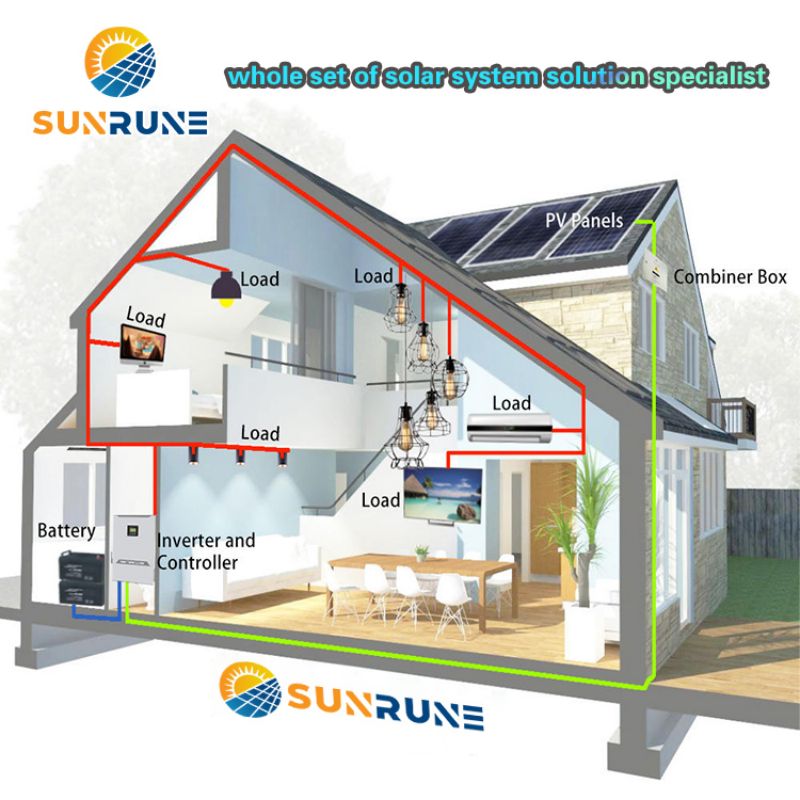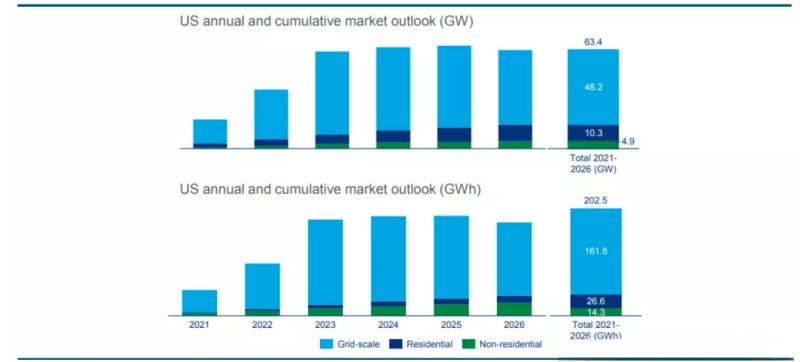Europe and the United States household energy storage high-speed development
Under the goal of "Bicarbon", new energy represented by PV has seen rapid growth under favorable policies. With the maturity of energy storage technology and cost reduction, household scenarios are also gradually growing into an important field of new energy applications. Especially in overseas markets, residential electricity prices continue to rise under the economy of household energy storage gradually highlighted, coupled with the financial subsidies of governments to further promote its rapid popularization.

From the demand side, on the one hand, the continuous rise in electricity prices led to a large increase in demand for household energy storage. Since the Russian-Ukrainian conflict, European countries are mired in inflation and energy crisis, energy prices continue to rise. According to the Intercontinental Exchange (ICE) in London, the natural gas futures price reached $2,861.6 per 1,000 cubic meters on August 22, a record high for a number of European natural gas hubs, reaching the highest record since the 1996 run. The continued tight supply of natural gas has led to rising electricity prices. This has greatly stimulated the use of photovoltaic (PV) power generation in domestic scenarios, and household energy storage has exploded.
On the other hand, poor power supply stability has galvanized residential demand. Overseas part of the community dispersed, the high cost of grid construction and subsequent upgrading is weak, grid coordination capacity is weak, especially under the influence of extreme weather, a variety of large-scale power outages occur frequently, the stability of power supply to the residents is poor. And household energy storage can provide emergency power when the public power grid failure or unstable power supply, improve the stability of electricity.

From the supply side, photovoltaic in technology, application and other aspects of the formation of a more mature system, and in some overseas developed regions with a high penetration rate. With the photovoltaic development mode from subsidized, full Internet access type to its own economic drive, self-generated self-use change, supporting the demand for energy storage gradually come to the fore.
Under the influence of the epidemic, supply chain shortage and other factors, the global new household energy storage market in 2021 still maintains a high growth trend, with a new installed size of 18.3GW of power storage projects in operation, an increase of 185% year-on-year. Among them, Europe and the United States household energy storage in 2021, to double the annual growth rate showed explosive growth trend. 2021 U.S. installed capacity of energy storage reached 3.51GW/10.50GWh, quadrupled year-on-year. Relevant data show that the total new installed capacity will reach 63.4GW/202.5GWh in 2021-2026, of which household can reach 4.9GW/14.3GWh.
Fierce competition among enterprises in the field of household energy storage
The demand side and supply side create the market heat, and global enterprises are also accelerating the layout of the household energy storage field. Relevant data shows that the TOP3 household energy storage suppliers in 2021 are Tesla, Pylon Technology and BYD, accounting for 18%, 14% and 11% respectively.
In order to make the economy of household energy storage further highlighted in the market, in July this year, Tesla joined forces with California utility PG&E to create a new virtual power plant, providing eligible Powerwall users with a compensation incentive of $2 per kWh. It is reported that there will be 50,000 Powerwall users eligible for the subsidy. If we estimate from the market demand for electricity and the number of Powerwall users, every time the power is dispatched, the user will receive $10-60 in revenue
At the same time, to cope with the rapid growth of market demand, domestic enterprises are also accelerating the expansion of production. In June this year, Pylon Technology accelerated the expansion of the core end of the proposed issuance of shares to a specific object to raise a total of no more than 5 billion yuan, for investment in the construction of an annual production capacity of 10GWh core and system assembly production line and related ancillary facilities, headquarters and industrialization base project and supplementary working capital.
Another example is Goodwe a pioneer in household energy storage inverters, which launched LynxHome F series high-voltage energy storage batteries with stacked design, which can realize the flexible combination of 6.6-16kWh battery capacity expansion, and can provide strong power for household power supply. Battery company PengHui energy in one fell swoop to become the national energy storage battery shipments in 2021 TOP2 enterprises, it previously said, the company's household energy storage products last year has passed the certification of Europe and Australia, and has received a large number of orders.
Household energy storage track "long slope thick snow"?
The industry generally believes that this year is the first year of the energy storage market. The current growth of household energy storage, so that this statement has been verified. So, in the long run, household energy storage market "slope" and how long it will be?
From the point of view of the cost of residential use, household energy storage and household photovoltaic supporting more economical. In the past two years, household photovoltaic penetration rate has increased greatly. According to Infolink statistics, it is expected that the U.S. and Germany's household PV penetration rate will increase from 3.3% and 11.1% to 6.6% and 21.5% in 2025. At the same time, the U.S., Germany's optical storage integration penetration rate is also improving, will be from 0.25% in 2020, 2.39%, to 1.24% in 2025, 10.02%, to enhance the increase of 4.96 times, 4.19 times.
Optical storage penetration rate increase, will bring some development space for household energy storage. And with the increase in electric vehicles and other power equipment, the per capita electricity consumption of residents will also increase, thus promoting the enhancement of the power of a single optical storage system, bringing greater industry growth space.
At present, the global household energy storage incremental market is mainly concentrated in Europe and the United States represented by Germany and the United States, and its growth is driven by policy support, household PV installations and energy storage penetration rate increase.HIS Markit data show that in 2020, the global household energy storage is mainly concentrated in Europe, Germany, Italy, the United Kingdom, as well as Japan, Australia, the United States and so on, in which the combined household energy storage capacity of Germany, the United States, Japan and Australia's combined share of household energy storage reaches 74.8%.
According to the 2021 data, in the household energy storage market, Tesla, with its outstanding product strength and brand effect, accounted for 15% of the global household energy storage market, followed by Pylon Technology, an enterprise from China, with a share of 13%. In addition, domestic manufacturers such as GREAT POWER, TITHIUM, SUNGROW, DEYE, Goodwe,sofar New Energy, etc. are also accelerating the layout of the overseas market.
Generally speaking, a complete set of household energy storage including photovoltaic, energy storage inverter, energy storage battery and other parts and components and other costs, of which the most core is the energy storage battery and energy storage inverter. 2021 average hardware cost of household energy storage is about 2.8 yuan / Wh, according to the energy storage system average annual cost decline of 5% measurement, is expected to 2025 the household energy storage market size of about 111.7 billion yuan.
Since this year, the demand for energy storage equipment in Europe has grown significantly. In order to ensure market supply, China's energy storage industry chain also responded quickly. Customs statistics show that in the first half of this year, China's exports of lithium-ion batteries increased by 36.8% year-on-year, and the export volume of inverters soared by 576.7% year-on-year. At present, household energy storage with small-capacity batteries continue to be in short supply, PV inverter manufacturers through the original channel smooth shipments of energy storage inverter products, selling price and profitability to maintain a high level, household energy storage products become an important point of growth in its future performance.
Post time: Nov-28-2023